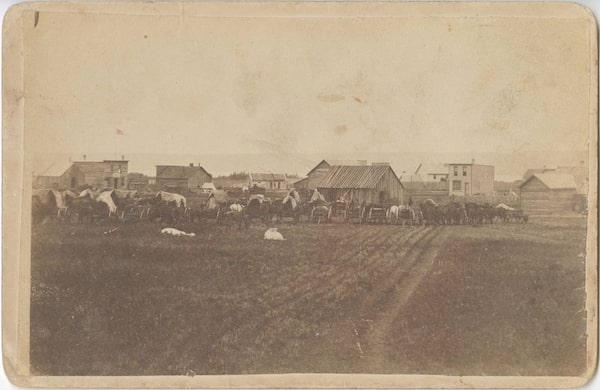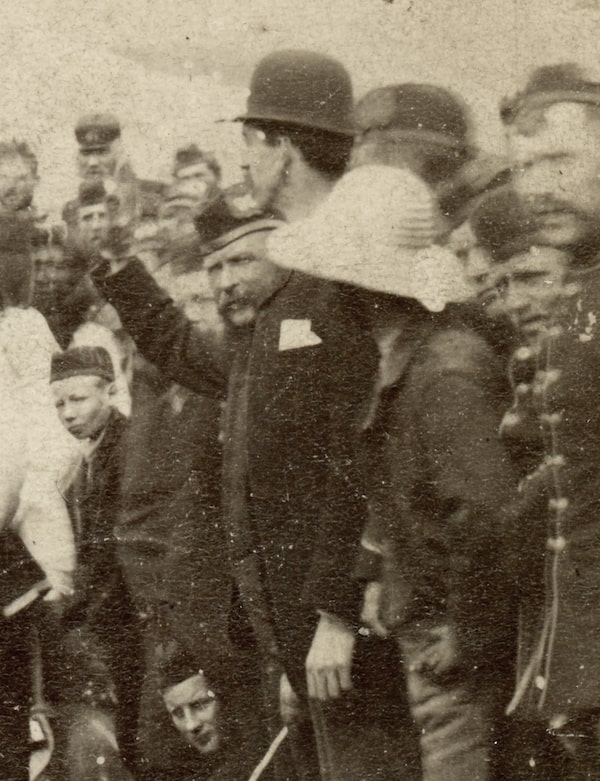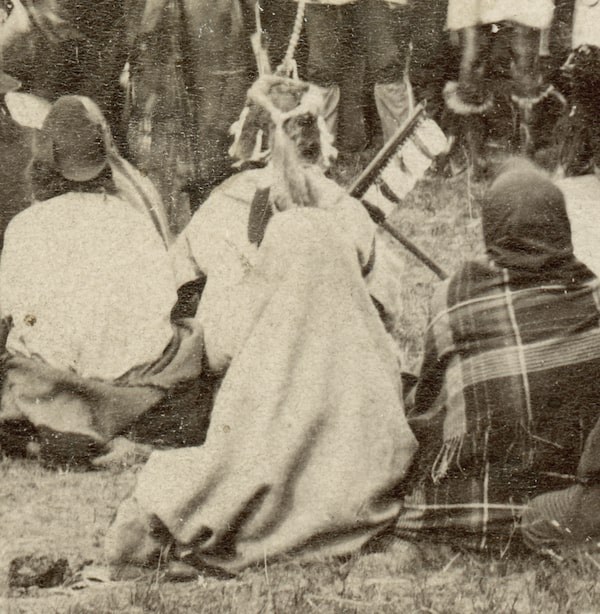:format(jpeg)/cloudfront-us-east-1.images.arcpublishing.com/tgam/JKYO6GRCMRFDHHKJIHWB3J3PLQ.jpg)
Bill Waiser is a historian and the author of A World We Have Lost: Saskatchewan Before 1905, which won the 2016 Governor-General’s Literary Award for Non-Fiction.
In 1989, Gerry Dupont, who ran a stucco repair business, struck up a conversation with a woman named Carla Davidson at Winnipeg’s Festival du Voyageur – sparking a mystery that would resonate more than three decades later.
Gerry told Carla that he was there because of his interest in Métis leader Louis Riel. Carla replied that her great-grandfather had actually served in the North-West Field Force during the 1885 North-West Resistance (also known as the North-West Rebellion), and that she had found six photographs from 1885 in the attic of his old home.
Intrigued, Gerry arranged to see the pictures and quickly struck a deal. Gerry said that Carla gave him the photos in exchange for a fur hat, like the one he was wearing at the festival – and the promise that he would donate them one day to an archival institution.
Gerry kept his pledge. After first confirming that the photographs were indeed authentic, he recently gave them to the University of Winnipeg’s archives in 2021.
University archivist Brett Lougheed knew fairly quickly that he had something special – but wasn’t sure quite how “unique they might be.”
A lithograph, based on sketches from a Canadian sergeant, shows the battle in 1885 for Batoche, where Louis Riel made his last stand during the North-West Rebellion.Library and Archives Canada
On March 19, 1885, Louis Riel declared a provisional government at Batoche, in present-day central Saskatchewan, in an effort to force John A. Macdonald’s Conservative government to negotiate with the Métis and deal with their grievances. But a deadly clash between the Métis and the North-West Mounted Police at Duck Lake one week later prompted the Macdonald government to quickly mobilize a large militia force to put down the resistance.
The swiftness of Ottawa’s response was motivated, at least in part, by the misguided belief that the Cree would join forces with Riel in a combined First Nations-Métis insurgency that could sweep across the western interior like a prairie fire. As Edgar Dewdney, who served as both lieutenant-governor and Indian Commissioner for the North-West Territories, had telegraphed the prime minister: “Situation looks serious.”
Major-General Frederick Middleton, the 60-year-old commander of the hastily assembled Canadian militia, was handed the job of confronting Riel and his Métis fighters. “Old Fred,” as he was mockingly called by his men, decided from the outset to concentrate his army’s energies at Batoche, believing that a quick knockout blow at the heart of Riel’s resistance would end the trouble.
So he gathered the first troops in the field at Fort Qu’Appelle, just north of the new Canadian Pacific Railway mainline, and began to march north on April 6, 1885, through the Touchwood Hills. Middleton was supremely confident that any Indigenous resistance would melt away before his force reached Métis headquarters: “Almost certain Riel and people will bolt,” he telegraphed the minister of the militia from the field. His only worry was the inclement spring weather.

Fort Qu'Appelle in 1885. It would be another 20 years before this area became part of the province of Saskatchewan; in Riel's time it was within the North-West Territories, along with what is now Alberta.University of Winnipeg archives
Five of the six photographs Gerry Dupont donated feature members of the 95th Manitoba Grenadiers (which later became the Winnipeg Light Infantry) and their camp at Fort Qu’Appelle, in what was then the North-West Territories. The images are generally poor in quality, but collectively, they give some sense of the military presence in the area.
E.J. Pattison of Neepawa, Man. – Carla Davidson’s grandfather – had scribbled on the back of one of the photographs that his dad, John, was among the assembled men. A check of Canadian military honours confirms that John Pattison was indeed awarded the North-West Canada medal for service in 1885. But the sixth photograph in the set was curious. It shows members of the North-West Field Force, including Middleton, watching a First Nations ceremony. On the back of the photograph, E.J. Pattison had written: “Story almost forgotten but this picture would be the surrender of some of the subchiefs at Fort Qu’Appelle at the end of the Rebellion.”
It’s a puzzler, because Middleton never returned to Fort Qu’Appelle after marching north to deal with Riel. Nor did any First Nations chiefs in the area surrender to Middleton. In fact, there is no record of any meeting between the major-general and local bands at Fort Qu’Appelle. Stranger still, military specialist Scott Whiting of Parks Canada examined the photos and noted that many of the soldiers in the First Nations ceremony photograph are wearing scarlet line-infantry uniforms – not the rifle green nor the dark blue of the two Winnipeg regiments stationed at Fort Qu’Appelle at the time. The buttons weren’t a match, either.
He also pointed out that the 95th Manitoba Grenadiers – John Pattison’s unit – was not mobilized until April 10, four days after Middleton had left Fort Qu’Appelle for Batoche. Had the photograph perhaps been taken some place else?
Middleton’s records provided the answer. In the general’s official 1885 report on military operations in the North-West, his April 10 entry reads in part: “halted 2 miles short of the Salt Plains [what is today the Quill Lakes] … I had a meeting or, as it is called in this part of the country, a ‘Pow-wow,’ with the Indian Chief Day Star and his people at Indian Farm. They, of course, expressed the greatest loyalty, and received the usual present of tea, tobacco, and flour.” A newspaper search confirmed the meeting; two men with Middleton had written home about the event, and their letters were published in their local newspapers.
With this detail, the photo reveals itself as a moment of symbolism – and disappointment.

Major-General Frederick Middleton raises his hand in the photo with Day Star's followers.University of Winnipeg Archives
On Sept. 15, 1874, on behalf of his Plains Cree followers, Chief Day Star (Kīsikāwacāhk) was among the 13 chiefs who signed Treaty Four at Fort Qu’Appelle. Two years later, the band’s reserve was surveyed in the Big Touchwood Hills, north of present-day Punnichy, Sask.
Eileen Kinequon (kīnikwān), a descendant of Day Star, and her husband John Cuthand, a knowledge keeper from the Little Pine First Nation, said that Day Star was ridiculed by other Plains Cree chiefs for asking the Canadian government for a reserve “in the trees.” But they explained that Day Star had selected land that had come to him in a vision. The reserve included the highest hill in the region, known as Blue Hill, or sîpihkpowacîhk, which is a sacred place to this day; Day Star First Nation members sometimes refer to themselves as the Blue Hill People (sîpihkpowacîwiyiniwak).
Day Star worked hard to bring the reserve under cultivation. His farming efforts, especially in his garden, were recognized in 1881; during a visit with local First Nations leaders at Fort Qu’Appelle, the Marquess of Lorne, who was then Canada’s governor-general, presented him with a silver medal, awards given to those who show “the best disposition to carry out the treaties.”
Day Star lived up to that expectation when he welcomed Middleton and the men of “C” Company, Infantry School Corps – wearing their scarlet line-infantry uniforms, as seen in that sixth photograph – to the Touchwood Hills in April, 1885.
It’s not clear where Day Star is in the photograph. No contemporaneous images of the chief exist today – only a portrait sketch. Day Star First Nation Chief Lloyd Buffalo and two councillors studied the photo for almost an hour in August, 2022, but they were not able to find the nation’s eponymous leader.
Elder John Cuthand and his brother Doug, a First Nations filmmaker and journalist, have suggested that Day Star is probably seated with his back to the camera, watching the ceremony with his family and headmen beside him. They say he’s likely the one with the staff, wearing a headdress; Mr. Buffalo believes that this could be the chief.

The Cuthand brothers suspect this figure in the photo, seated and wearing a headdress, is Day Star.University of Winnipeg Archives
The person who took the shot is also unknown, though it might have been the itinerant photographer Oliver Buell, who took a series of photos in 1885 and travelled with the Middleton column.
But there is one certainty about the image: what is being depicted. After affirming their loyalty to the Crown during the resistance, Day Star and his band were holding a pipe-stem ceremony for Middleton and his soldiers. The short, stout general with the walrus mustache and side cap is standing on the far right of the frame, raising his right arm in approval, looking directly into the camera, clearly revelling in the honour.
Unfortunately, Day Star’s message was lost on the Canadian state. Even though any First Nations involvement in the resistance was isolated, sporadic and limited, the Macdonald government deliberately used the western crisis “for our own purposes,” as the prime minister himself wrote in a letter to Lord Lansdowne, then the governor-general. At the end of the North-West resistance, the Indian Affairs department adopted a number of coercive and interfering Indian Affairs policies, such as the pass system, to control and manage the lives of First Nations people. The goal was to crush their independence, while keeping them separate from the white settler community. It was as if Day Star and other chiefs had never made their pledge to remain loyal during the troubles.
That’s what makes the photograph so significant, if not instructive. Canada’s heavy-handed treatment of prairie First Nations after 1885 was a betrayal of the treaty relationship. There could have been a different ending to part of the resistance story – if only the Canadian government had followed the lead of chiefs such as Day Star.
To learn more about the six photos, visit the collection at the University of Winnipeg’s archives or view the series online.